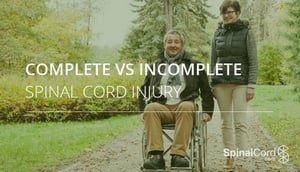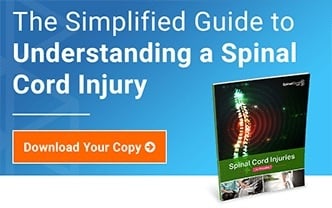Complete vs Incomplete Spinal Cord Injury: What You Need to Know
The effects of spinal cord injuries (SCIs) vary greatly depending on the severity and location of the damage to the spinal cord. No two injuries are the same, and their outcomes also can be completely different based on a number of factors, including the level of post-trauma early intervention care and physical therapy the injured person receives.

A generation ago, complete spinal cord injuries were the majority among spinal cord injury survivors. Thanks to excellent rapid response, improved technology, and a better understanding of spinal cord injuries, complete spinal cord injuries make up less than half of SCI injuries today. Understanding the difference between these two injury types can help you better predict your recovery trajectory.
What is a Complete Spinal Cord Injury?
Complete spinal cord injuries occur when the spinal cord is fully compressed or severed, completely eliminating the brain's ability to send signals below the point of injury.
What is an Incomplete Spinal Cord Injury?
Incomplete spinal cord injuries encompass any SCI in which a person retains some feeling and/or function below the injury site in one or more areas of the body.
These types of spinal cord injuries can have an enormous variety of effects. For example, an incomplete spinal cord injury may be so mild that there is barely any muscle weakness or other signs that an injury has occurred. Or, it can be so severe that it results in a person having symptoms similar a complete spinal cord injury.
What is the Difference Between a Complete and Incomplete Spinal Cord Injury?
In complete spinal cord injuries, the spinal cord is fully severed and function below the injury site is eliminated. In comparison, incomplete SCIs occur when the spinal cord is compressed or injured, but the brain's ability to send signals below the site of the injury is not completely removed. Incomplete SCIs are the most varied and account for more than 65% of all spinal cord-related injuries.
When comparing complete and incomplete spinal cord injuries, it is not always easy to discern which type you have. Particularly in the first weeks after an injury, swelling may interfere with function. When swelling goes down, an injury that appeared to be a complete spinal cord injury might turn out to be incomplete.
Types of Spinal Cord Injuries
An incomplete spinal cord injury typically manifests in one of several ways:
1. Anterior Cord Syndrome
An anterior spinal cord injury affects the front of the spinal cord and interferes with motor and sensory pathways, including touch, pain and temperature. Many SCI survivors with anterior cord syndrome can recover some movement.
2. Brown-Sequard Syndrome
This rare, but serious, condition is a lesion on the spinal cord that results in the loss of some motor and sensory functions below the injury site. A Brown-Sequard spinal cord injury commonly asymmetrically affects the side of the body in which the spinal damage occurred.
3. Cauda Equina Syndrome
This condition affects the bundle of nerve roots around the lumbar level of the spinal cord and often is the result of spinal compression. It causes a loss of sensation and muscle weakness—but not necessarily a loss of movement. Repair or regeneration of some of the nerves is possible to help improve function.
4. Central Cord Syndrome
This syndrome occurs when an injury impacts the center of the cervical spinal cord. It often results in a loss of sensation. Survivors may recover some movement in their legs but arm movement recovery is rarer.
5. Conus Medullaris Syndrome
Affecting the sacral cord and lumbar nerve roots, this syndrome often affects control of excretory functions, lower limb reflexes, and often shares symptoms with cauda equina syndrome.
6. Posterior Cord Syndrome
This syndrome occurs due to damage to the rear of the spinal cord. Most survivors maintain good movement, muscle tone and posture. However, they often struggle with poor coordination skills.
How Complete and Incomplete Spinal Cord Injuries Are Caused
Whether a spinal cord injury is complete or incomplete has little to do with the source of the injury. A gunshot can fully or partially sever the spinal cord, and the outcome provides little insight into how severe the initial injury was. Something as seemingly innocuous as the position in which you were sitting at the time of the injury may determine whether it is complete or incomplete. The leading causes of both complete and incomplete spinal cord injuries are:
- Car accidents (39.3%)
- Falls (31.8%)
- Violence, primarily gunshot wounds (13.5%)
- Sports (8%)
Other causes of SCIs include infections, unknown injuries, medical malpractice, and similar injury sources. If you suspect that you or your loved one has been the victim of medical malpractice, you may be able to receive financial compensation. Time is a key factor, both in terms of your potential rehabilitation from a spinal cord injury as well as your ability to file a lawsuit due to each state’s statutes of limitations.
Symptoms of Complete SCIs
A complete spinal cord injury removes the brain's ability to send signals down the spinal cord below the site of the injury. Thus, a complete spinal cord injury in your lumbar spinal cord might lead to paralysis below the waist though movement in your arms and upper body is preserved.
In the days immediately following your spinal cord injury, the symptoms of a complete and incomplete spinal cord injury are virtually indistinguishable. Over time, though, small differences may begin to emerge.
Those characteristics include:
- Loss of sensation below the site of the injury.
- Complete loss of motion below the site of the injury.
- Difficulty controlling your bladder and bowels.
- If the injury is high enough in your spinal cord, difficulty breathing on your own.
Symptoms of Incomplete SCIs
With an incomplete spinal cord injury, the spinal cord's functions are only partially compromised. The effects of an incomplete spinal cord injury, then, vary more widely. Someone with an incomplete spinal cord injury due to an infection may retain significant function. But a gunshot wound survivors whose injury is high on the spine but incomplete may face obstacles similar to those faced by a complete spinal cord injury survivor.
Some characteristics of an incomplete spinal cord injury include:
- Retaining some sensation below the site of the injury. The sense of feeling may come and go, and may be much weaker than the sensations you used to experience.
- Being able to move some muscles below the site of the injury. The extent of movement may vary, and you may have good control over some muscles, but no control over others.
- Pain below the injury. Many incomplete spinal cord injury survivors report issues with chronic pain.
With both incomplete and complete spinal cord injuries, mobility impairments, including tetraplegia/quadriplegia and complete paraplegia, are common.
Can You Fix a Complete or Incomplete SCI?
Since incomplete injuries allow your spinal cord to retain some function and to communicate some signals from the brain, survivors of incomplete spinal cord injuries often progress in recovery more rapidly than those with complete SCIs.
If you’ve received a diagnosis of a complete or incomplete spinal cord injury, it does not mean that recovery is impossible. Some factors that play critical roles in your recovery include the rehabilitative and medical care you receive early in your journey to recovery, having a positive attitude, and being willing to lean on your existing support system.
Differences in Treatment
Because incomplete spinal cord injuries allow the spinal cord to retain some function, incomplete injury survivors often make faster progress in recovery. This is not the only factor influencing recovery, though.
Other significant issues include:
- The location of the injury. The higher the injury is, the more unlikely recovery becomes.
- Your overall health. Health factors can complicate the recovery process. An infection, for instance, may increase swelling, thereby slowing down the recovery journey.
- The quality of medical care you receive. Spinal cord injury survivors who seek care at facilities offering Model Systems care generally have better outcomes.
- Your commitment to physical therapy. Physical therapy is challenging, and often painful. But it is the most effective way to teach your brain how to communicate with the rest of your body.
Differences in Recovery
Spinal cord injuries are unpredictable, and though a complete spinal cord injury is a more severe injury, it is neither a death sentence nor a reason to be hopeless. Luck, dedication to recovery, and good medical care can all help you move toward wholeness and wellness.
Much remains to be understood about spinal cord injuries, and as technology changes and research improves, doctors may develop novel and effective ways for treating even the most severe spinal cord injuries.
SCI Grading Scale
It isn’t just a matter of your cord being fully intact or completely severed; there are issues of spinal contusion (bruising), compression, and inflammation that can affect your brain’s ability to send signals.
As a result of these variations, there are different levels or “grades” that are used by medical professionals to assess the severity of the damage to your cord, ranging from “A” to “E.” The higher the grade, the more severe the damage tends to be.
Let’s take a look at the American Spinal Injury Association’s (ASIA’s) Impairment Scale to learn more about what each grade means for you.
A – This is considered a complete SCI. No sensory or motor function is preserved (including your sacral segments S4-S5).
B – Your sensory function — but not motor function — is preserved below the neurological level (including the sacral segments S4-S5).
C – This is an incomplete spinal cord injury in which your motor function is preserved below the neurological level, or you meet grade B criteria and have some motor function.
D – You meet the criteria defined by grade C by having preserved motor function as well as at least half of your muscle functions having a grade of three or higher.
E – Your motor function and sensory scores are normal. You may have suffered a spinal cord injury, but you will not experience paralysis and loss of sensations. However, there may be neurological or muscular changes or deficits.
Don’t lose heart: Know that you don’t have to face this situation alone. Seek out peer support through our SpinalCord.com online community of survivors and family members. Learning to cope with a SCI is an important and necessary step in your recuperation, and early intervention is key to your recovery after sustaining a traumatic injury.
Stay Updated on Advancements On Traumatic Brain &
Spinal Cord Injuries
About the Author





